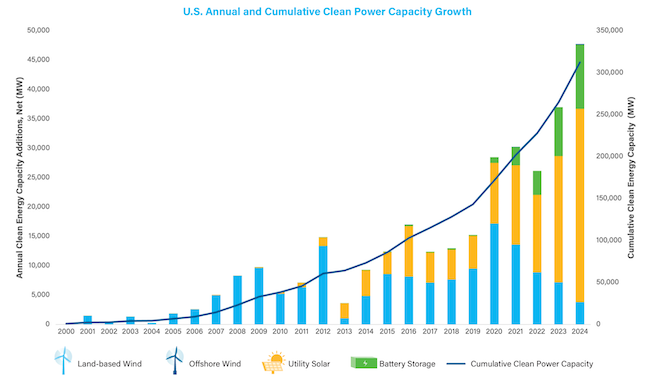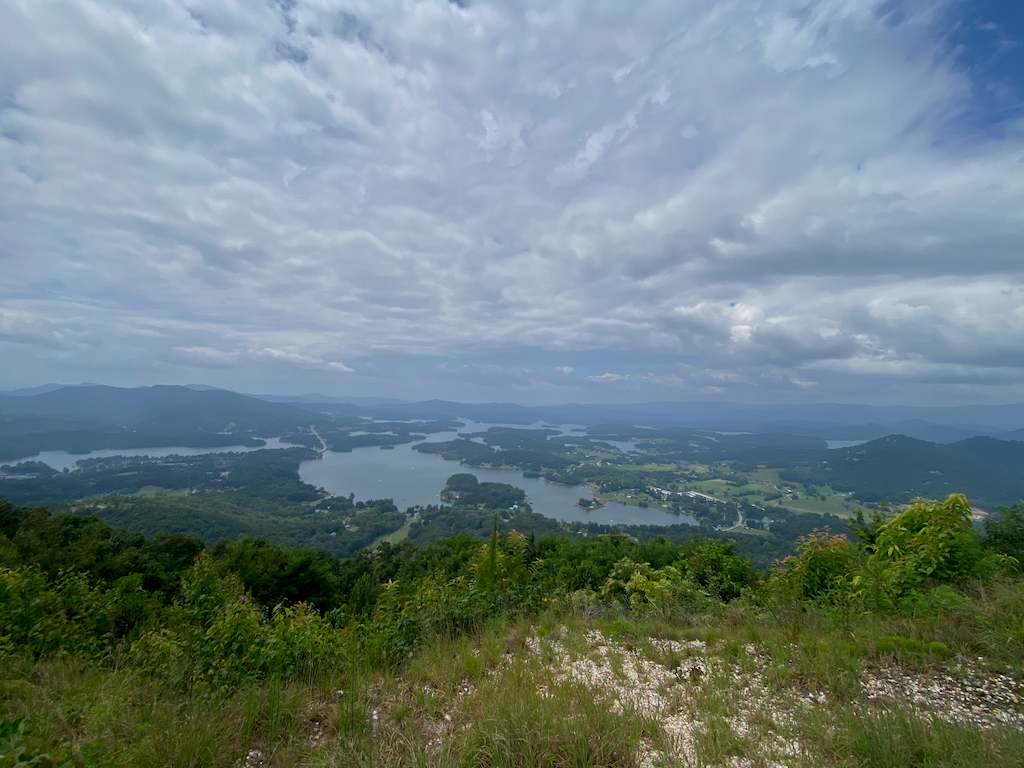
CCL volunteers on the Capitol steps for our annual group photo
Reflections from Capitol Hill: Climate advocacy and a moonshot mindset
By CCL volunteer Joel McKinnon
Each year, several hundred Citizens’ Climate Lobby volunteers travel to Washington, D.C., at their own expense to participate in CCL’s Summer Conference and Lobby Day, holding hundreds of meetings with legislators on Capitol Hill. This year, for the first time, I decided to join them. By the time it was over, I was left with a renewed sense of possibility—not only in what we can accomplish as climate advocates, but in how we connect as human beings in this critical work.

Joel McKinnon
Let’s start with the basics: I was there, suit and all. A rented one, to be exact. Somewhere between the personal awkwardness of being dressed like a businessman and the shoes that quickly turned into instruments of mild torture, I found myself reflecting on how odd and wonderful it is to do something so uncomfortable for something that matters so much. Climate work is rarely glamorous, but it does have moments of unexpected grace, and this event brought many.
Our meetings on the Hill were thoughtful, serious, and at times, deeply human. In Rep. Sam Liccardo’s office, there was a striking constellation of personal stories: a mother and daughter speaking with grace and clarity, a Spanish teacher reconnecting serendipitously with a former student who now serves on the congressional staff, and a husband and wife seasoned in CCL advocacy grounding the conversation with perspective and calm purpose. The discussion was energized, sincere, and open to meaningful dialogue.
The conversation with Rep. Jerry Panetta’s aide was similarly warm, frank, and collaborative. Our team was received with a sense of familiarity, a quiet nod to the long-term relationships we’ve built. The staffer’s stories of late-night phone calls during past legislative efforts, and her reflections on political realities, revealed the emotional labor behind policy work and the role we play as trusted outside partners.
But advocacy wasn’t the only kind of connection this trip offered.
I also carved out time for a different kind of fuel: reconnecting with people who’ve been part of my journey. I met up with my brother in Pittsburgh before the trip to watch my hometown team play baseball. I spent time with Tobias, a friend I’d met online and finally met in person in Philadelphia. And in D.C., I reunited with Darryl, an old bandmate and drummer, who took me on an inspiring side trip the Sunday before the conference.
We spent the afternoon at the Smithsonian National Air and Space Museum, where the Wright Brothers exhibit and the Race to the Moon wing stopped me in my tracks. One particular multimedia piece explored the cultural and political tensions of the 1960s — civil rights, war, economic disparity — all unfolding alongside an unprecedented effort of human collaboration and technical innovation that culminated in landing a person on the moon. It framed the moonshot not as a solitary feat, but as a symphony of effort from thousands of unsung contributors.
Standing there, I couldn’t help but draw the parallel to our climate crisis. The space race wasn’t just about rockets. It was about will, imagination, and urgency. It required us to act across divides, invent new technologies, and, most importantly, believe we could do something no one had done before.
That exhibit, quiet, moving, and brilliantly assembled, reminded me that the path ahead on climate isn’t hopeless. It’s just hard. But we as a people have done hard things, nearly impossible things, before.
So yes, I’ll remember the talking points. But I’ll also remember the aching shoes, the laughter with friends, the warmth of a chance hallway encounter, and that lingering feeling I had standing next to the Apollo capsule. We can do this if we have the will, the spirit, and the desire to put in the work it takes. This trip gave me a sense of what’s possible when all seems chaotic and confused. We are still a government of, by, and for the people. And we have to reach further than ever before to do the right thing for the future of the planet we live on.
Joel McKinnon is a volunteer in CCL’s San Mateo, California, chapter.
The post Reflections from Capitol Hill: Climate advocacy and a moonshot mindset appeared first on Citizens' Climate Lobby.
Reflections from Capitol Hill: Climate advocacy and a moonshot mindset
Greenhouse Gases
DeBriefed 22 August 2025: Pakistan floods; China emissions drop; Climate-adaptive architecture
Welcome to Carbon Brief’s DeBriefed.
An essential guide to the week’s key developments relating to climate change.
This week
Floods and fires
PAKISTAN FLOODS: Torrential rain in northern Pakistan killed almost 400 people over five days, Agence-France Press reported. The rains have caused flooding and landslides that have “swept away entire villages, leaving many residents trapped in the rubble and scores missing”, it added. Bloomberg reported that the monsoon season has killed at least 1,860 people in India and Pakistan, “with flash floods, landslides and inundated cities exposing the region’s growing vulnerability to climate-related disasters”.
HEAVY RAIN IN CHINA: In China’s Inner Mongolia province, 13 people have been killed in floods caused by heavy rains, reported Reuters. It added that “heavy rainfall and severe floods that meteorologists link to climate change” are posing “major challenges”, including “economic losses running into billions”.
SPANISH WILDFIRES: Spain has continued to battle several major wildfires, even as temperatures across the country began to drop, reported the Associated Press. The fires have burned a total area twice the size of London this year, added the Daily Telegraph. The emissions from the wildfires have “surged to their highest levels in at least 23 years”, reported the Independent.
Around the world
- TRUMP REPORT ‘IRREGULARITIES’: A former head at the US Environmental Protection Agency has requested a correction to a recent misleading climate report from the Department of Energy, citing “legal and procedural irregularities”, reported Politico.
- SOARING SOLAR: Solar power generation in Britain has already surpassed the total for 2024, with more than 14 terawatt hours of electricity produced as of 16 August, the Financial Times reported.
- ‘CLASH OF VIEWS’: Incoming president of the COP30 climate summit, Brazilian diplomat André Corrêa do Lago, is preparing for a “clash of views” over how countries should respond to a review of their overdue climate plans, according to Climate Home News.
- TAX CREDITS: The US treasury department has issued guidance that “narrows which wind and solar energy projects” can receive the remaining tax credits set to be “largely eliminated” by the Republicans’ “big beautiful bill”, reported the Hill.
195%
The record increase in UK renewable energy capacity to gain planning permission in the second quarter of this year, when compared to the same period in 2024, reported the Financial Times.
Latest climate research
- The risk of rice production failure across Indian districts could increase by 26%, on average, due to climate change by 2055-84 | Environmental Research Letters
- Newborns across 33 African countries are more likely to die if their mothers are exposed to extreme heat during pregnancy | PNAS Nexus
- More than 13,800 square kilometres of giant panda habitat could “degrade” under a moderate-warming scenario | Global Change Biology
(For more, see Carbon Brief’s in-depth daily summaries of the top climate news stories on Monday, Tuesday, Wednesday, Thursday and Friday.)
Captured

Clean-energy growth helped China’s carbon dioxide (CO2) emissions fall during the first half of the year, despite an increase in electricity demand, new analysis for Carbon Brief found. Emissions in the first half of the year fell by 1% year-on-year, extending a declining trend that started in March 2024, the analysis said. CO2 output fell in China’s power sector by 3%, with the growth in solar power alone matching the rise in electricity demand in the country. Emissions also fell in the building materials, steel and heating industries sectors, the analysis added.
Spotlight
How architecture can support climate-adaptive design
This week, Carbon Brief interviews Prof Alice Moncaster, professor of sustainable construction at the University of the West of England, about how architecture can adapt to the growing pressures of climate change.
Carbon Brief: What are the biggest challenges with designing climate-adaptive buildings?
Alice Moncaster: Climate change is already producing far more frequent and extreme heatwaves across most of the world, as well as more severe storms leading to flash flooding and failing roof and subsurface drainage systems, and long periods of drought, meaning water shortages and shrinking ground leading to cracking buildings.
There are two huge challenges for designing buildings that can physically withstand these extremes. The first is perhaps the easier, which is the design of new buildings. This is critical in developing nations where rapidly increasing and urbanising populations need a parallel expansion in their built environment.
The second is more complex and often seen as less exciting, but is essential to developed countries with a mature building stock and lower or no population growth – how to retrofit our existing buildings from all previous decades to withstand the new weather.
Really, there is a third, less talked about challenge. At the same time as designing and retrofitting for increasingly extreme climates, this major construction programme needs to add the very minimum to greenhouse gas emissions. We cannot just continue to throw money and materials at adaptation because, at the same time, we need to reduce our carbon emissions as much as possible in order to limit further climate change.
CB: There is a lot of focus on air conditioning (AC) currently, but how can the architectural design of a building also help to keep people cool in a warming climate?
AM: This is becoming a huge issue. AC not only uses energy, but adding portable AC units kicks heat out of the building, making the outside even hotter. Passive design strategies have existed for millennia in hotter countries.
These are focused on four approaches.
First, ventilation is increasingly an issue in countries where buildings are constructed to keep the warmth in and, therefore, are built to be airtight. A passive approach is to design in a stack or chimney effect, with an opening at the top of the building, often above a central atrium.
Second, the thermal inertia of a building has long been understood as essential for keeping buildings cool in hot summers. Rather than plasterboard, if wall or floor surfaces are exposed stone, brick or concrete, they will stay cool for many hours longer (as anyone who has been in an old church will know).
A method which combines ventilation with thermal inertia is a “jaali wall”, a perforated stone or brick screen used in some traditional Asian architecture.

Third, shading the outside of the building from the sun is essential. Many Mediterranean buildings include external shutters, which keep the sun off the windows.
The final approach is how the building is used. Bedroom spaces are often moved in hotter countries to cooler areas of the house or even outside.
CB: Do you think there is enough centering of climate-adaptive design within architectural practice currently?
AM: I believe that there is a huge amount of knowledge among our architects and building professionals about climate-adaptive – and climate-mitigating – design, but that it is very hard to make it actually happen.
I think it is partly due to the slow-to-change nature of the construction sector, across skills, materials and supply chains. But I increasingly think that underlying the sector are the powerful vested interests, which means that traditional materials still dominate.
Procurement practices also often do little to support innovation and the understanding of risk has not yet caught up with the very real risk of climate change.
Watch, read, listen
MASS EXTINCTION: A long read in the Guardian questioned whether climate change is leading towards “another Great Dying”.
A GOOD PLANET: On a New Scientist podcast, climate scientists Kate Marvel and Tim Lenton discussed how to fix climate change, quipping: “All of the other planets out there are just complete garbage. The Earth is the only good place.”
COOLED VS COOKED: A guest essay in the New York Times discussed the new American inequality – those who are “cooked” and those who are “cooled” – as extreme heat becomes increasingly common in the US.
Coming up
- 26-29 August: 6th Forum of Ministers and Environment Authorities of Asia Pacific, Fiji
- 24-28 August: World Water Week 2025, Stockholm, Sweden
- 27 August: UN Environment Programme sixth meeting of the open-ended ad hoc group on measurability and indicators, online
Pick of the jobs
- British Antarctic Survey, project manager – Rothera Renewable Energy | Salary: £56,509-£62,159. Location: Cambridge/Antarctica
- ClientEarth, UK environment lawyer | Salary: £56,991. Location: London
- The New York Times, deputy editor, climate desk | Salary: $150,000-$175,000. Location: Hybrid/New York
- Indigenous Climate Action, climate leadership coordinator | Salary: $55,000- $65,000. Location: Remote
- India Climate Collaborative, programme manager – heat | Salary: Unknown. Location: Mumbai/ Delhi/Bengaluru
DeBriefed is edited by Daisy Dunne. Please send any tips or feedback to debriefed@carbonbrief.org.
This is an online version of Carbon Brief’s weekly DeBriefed email newsletter. Subscribe for free here.
The post DeBriefed 22 August 2025: Pakistan floods; China emissions drop; Climate-adaptive architecture appeared first on Carbon Brief.
DeBriefed 22 August 2025: Pakistan floods; China emissions drop; Climate-adaptive architecture
Greenhouse Gases
What we achieved by passing and protecting the IRA
What we achieved by passing and protecting the IRA
By Dana Nuccitelli
We’ve been riding a climate policy roller coaster over the past four years. It began with Democrats controlling the House, Senate, and White House in 2021 and crafting a bill that was first called “Build Back Better.” It was initially conceived as a wide-ranging package incorporating both social and climate policies, potentially even including a price on carbon pollution.
But because of Democrats’ razor-thin majority in the Senate, passing the bill proved extremely difficult. After a year-long negotiation, it was whittled down to a smaller package that was renamed the Inflation Reduction Act. The IRA preserved most of Build Back Better’s proposed clean energy incentives, although a price on carbon pollution was unable to get the necessary support of 50 senators. News stories about the bill’s outlook lurched back and forth throughout 2021 and 2022 – one day it was dead, the next it was back on life support.
In order to keep climate policy in the package and ultimately push the IRA across the finish line, CCL volunteers went to work over that year, including holding 920 meetings with congressional offices, generating over 225,000 letters and calls to members of Congress, writing 2,117 letters to the editor, and publishing 676 op-eds. And it paid off! Congress finally passed the bill, and then-President Biden signed it into law in August 2022.
Over its first two-plus years, the IRA spurred hundreds of billions of dollars in clean energy investments and a rapid deployment of projects like solar farms and battery storage facilities. And most of the IRA’s grant and loan funding was successfully implemented. Those successes have already put a dent in America’s climate pollution.
In 2024, many Republicans including then-candidate Trump campaigned on terminating the whole IRA, which they mislabeled “the Green New Scam.” After the November election, they took control of the House, Senate, and White House. And so CCL volunteers went to work again, using data to lobby our representatives to defend the IRA.
Our efforts weren’t in vain. When President Trump signed the Republican budget bill into law on the Fourth of July, it didn’t terminate the whole IRA. Key clean energy tax credits for solar and wind energy were given a short runway before phasing out, and others for battery storage, geothermal, and nuclear power were largely preserved. And Senate Republicans listened to CCL volunteers and rejected the Trump administration’s efforts to throw up further significant roadblocks preventing clean energy projects from qualifying for the remaining tax credits.
This made us wonder, just how much did CCL’s efforts to pass and preserve the IRA’s clean energy tax credits accomplish for the climate?
A billion tons of climate pollution avoided
We don’t want to sugarcoat the difficult situation we’re facing – the big budget bill’s clean energy rollbacks have done a lot of damage, as has the EPA’s gutting of federal climate pollution regulations, which CCL has formally opposed.
But CCL’s work to pass and preserve the IRA’s clean energy tax credits nevertheless made a meaningful difference for American emissions and the climate. For example, many more solar farms and battery storage facilities have come online over the past two years, and will continue to come online over the next several years, than would have without the IRA or our successful defense of some of its provisions.

U.S. clean power generation capacity additions, showing big growth in solar and battery projects since the IRA was passed. Source: American Clean Power
The final budget bill also included provisions to blunt its effect on the rooftop solar industry, compared to earlier versions of the bill.

Projected rooftop solar additions under the IRA (green), the initial proposed House budget bill (red), and the final budget bill (OBBB; purple). Data from Ohm Analytics
After President Trump signed the budget bill into law, his administration tried to throw up more roadblocks to prevent clean energy projects from qualifying for its surviving tax credits. CCL volunteers went to work again, asking our representatives to reject those changes. Half a dozen senate Republicans did just that, and were largely successful.
But how much of a difference did it all make for the climate? To estimate the overall size of the IRA’s impact on America’s emissions, I looked at various emissions scenario projections from the expert energy systems modelers at the Princeton REPEAT project.
The results are illustrated in the chart below. The blue line represents how American climate pollution was forecast to decline if the IRA and EPA regulations had remained intact. The pink line represents the forecast adjusted to reflect the rollback of the EPA’s climate pollution regulations. The red line adds the impact of the big budget bill (OBBB). And the dashed purple line represents what our climate pollution would have looked like had the IRA never become law in the first place.

U.S. climate pollution projections under the scenarios described above. Adapted from forecasts by Princeton REPEAT.
Compared to a world in which the IRA never became law, we’ll save about 1 billion tons of carbon dioxide pollution over the next decade. That’s equivalent to permanently shutting down 26 coal power plants, or taking 23 million cars off the road.
It’s a far cry from the 3 billion tons of climate pollution that would have been avoided had the IRA remained fully intact, or the 7 billion tons had both the IRA and EPA regulations remained untouched. But it’s important to remember that every fraction of a degree and every ton of avoided carbon pollution makes a difference, and CCL’s work helped avoid a billion tons. That matters. Now let’s keep working towards avoiding the next billion tons!
The post What we achieved by passing and protecting the IRA appeared first on Citizens' Climate Lobby.
Greenhouse Gases
DeBriefed 5 September 2025: Pakistan floods hit 1.8m people; UK ‘eco-populism’; How warming threatens a man-made lake
Welcome to Carbon Brief’s DeBriefed.
An essential guide to the week’s key developments relating to climate change.
This week
Pakistan and India floods
EXTREME WEATHER: Heavy flooding forced half a million people to evacuate their homes in just 24 hours in Pakistan’s Punjab this week, the Associated Press reported. It brings the total number of people displaced since last month to 1.8 million, the newswire said. According to Arab News, at least 41 people have died as a result of the flooding since last week. The flooding has also destroyed thousands of acres of crops in Punjab, a province that accounts for 68% of Pakistan’s total annual food grain production, Bloomberg reported.
CROSS-BORDER EVENT: Meanwhile, in Indian Punjab, “at least 30 people have died and more than 354,000 have been affected” by flooding, BBC News reported. India also warned Pakistan about more cross-border flooding for the second time in as many weeks, as both countries reeled from monsoon rains, the Associated Press reported.
UK dividing lines
NEW FACE: Zack Polanski has been elected as the new leader of the Green Party of England and Wales in a landslide victory, the Financial Times reported. Polanski is an “outspoken campaigner who has argued his party needs to ‘connect with people’s anger’ and become more combative against ‘villains’, including oil major Shell and the ‘super-rich’”, the newspaper said. Polanksi wants to “replace” the ruling Labour party on a platform of “eco-populism”, according to BBC News.
NORTH SEA OIL: Meanwhile, the UK Conservative leader Kemi Badenoch pledged to drill “all” of the remaining oil and gas in the North Sea if elected, BBC News reported. [The Conservatives are polling third, at 17%.] In response to the speech, the Daily Telegraph‘s world economy editor Ambrose Evans-Pritchard argued that Badenoch’s plan would not “raise this country’s long-term output of oil and gas by more than homeopathic amounts” nor “move the needle on UK energy prices” (more below).
Around the world
- HIGHER AMBITIONS: The UN urged countries to set new, more ambitious national climate plans this month, ahead of this year’s COP30 summit in Belém, Brazil, Reuters reported.
- ‘JUNK SCIENCE’: A group of more than 85 climate scientists released a “scathing review” of the Trump administration’s misleading climate report, DeSmog reported.
- FOSSIL ENERGY: Russia said China had agreed to a massive new pipeline capable of importing as much as 50bn cubic metres of gas a year, the Financial Times reported.
- US PRESSURE: Reuters reported that the US is pressuring other countries to reject a UN deal on cutting emissions from shipping by threatening them with tariffs, visa restrictions and port levies.
- SWELTERING HEAT: Authorities in Japan and South Korea said 2025 was the hottest summer in their countries since records began, Al Jazeera reported.
- MITIGATION WORK: According to Bloomberg, Zimbabwe has published draft regulations to establish a National Climate Fund. The fund will finance projects “aimed at mitigating the impact of climate change and respond[ing] to emergencies”.
20%
The amount by which clean-energy production has surged in India this year, according to Reuters, citing data from the thinktank Ember.
Latest climate research
- “Extreme cold surges” have “robustly weakened in middle-to-high latitude continents during autumn and winter” due to climate change, according to a study in Nature Communications.
- A study published in npj Climate Action found that exposing people to moral appeals results in overall carbon footprint reduction and increased participation in civic and political climate action, regardless of ideological affiliation.
- The World Bank’s increase in climate finance spending since the Paris Agreement has been driven by projects with “low climate components”, according to a study in Climatic Change.
(For more, see Carbon Brief’s in-depth daily summaries of the top climate news stories on Monday, Tuesday, Wednesday, Thursday and Friday.)
Captured

A claim that gas produced in the North Sea emits “four times” less CO2 than imported liquified natural gas (LNG) featured prominently in both the Guardian and the Daily Telegraph this week, following Badenoch’s pledge to drill “all” the remaining oil and gas in the UK. However, this figure is highly misleading. It only refers to the emissions that come from the process of extracting and delivering the gas, which are much smaller than those from burning it. When both extraction and burning of the gas are taken into account, CO2 emissions from UK production are only around 15% lower than those from LNG imports, according to a new factcheck from Carbon Brief.
Spotlight
A man-made lake threatened by climate change
This week, Carbon Brief reports on how climate change is impacting the sustainability of a scenic nature reserve in the southern US.
In 1941, as World War 2 thickened, the US Congress approved a plan to construct a reservoir storage project on the Hiwassee River, a water body that cuts across the states of Georgia, North Carolina and Tennessee.
The dam, which came to be known as Chatuge after an 18th-century Cherokee village, was originally built for power generation purposes. However, after it was completed, it became more than a hydroelectric project.
In May 1942, the Towns County Lions Club started stocking fish in the newly created Lake Chatuge. In 1944, Clay County leased a tract of land for a public park.
Today, the park offers “scenic mountain views” and “panoramic views” of Lake Chatuge. The lake is also home to rare, endangered plant species and is an important source of drinking water.
However, Lake Chatuge’s future has been plunged into uncertainty after the Tennessee Valley Authority proposed a plan to repair the dam’s spillway, which could involve draining the lake’s water levels by 20 feet (6m) for up to eight years.
The TVA’s action is largely forward-thinking. While the dam and its spillway are in good condition, the public utility company is wary of extreme weather events made more likely by climate change.
In September 2024, Hurricane Helene tore through parts of Georgia and North Carolina, leaving more than 128 people dead across the US and uprooting communities in its wake. One analysis estimated that 44% of the economic damage from the storm can be attributed to human-caused climate change.

The Lake Chatuge area was largely spared, but officials worry that the next extreme weather event may not be far off.
“It’s the kind of event – the unusual storm event that can happen, that’s pretty rare – is what we’re looking out for,” a TVA project manager has said.
Meanwhile, aside from the imminent repairs made more likely by the increased possibility of extreme weather events, Lake Chatuge is also battling a parrot feather infestation, a phenomenon involving the spread of an invasive plant that has been linked to global warming in other parts of the US.
Saving Lake Chatuge
The threat posed by climate change to Lake Chatuge is not an isolated case. A July 2025 report by researchers at Utah State University found that climate change is affecting the social benefits of dams across the country.
Elsewhere in the world, the impact of extreme weather on ageing dams is wide ranging, including recently heightening tensions between India and Pakistan.
However, community members in the Lake Chatuge area are not giving up easily. A Facebook group dedicated to saving the lake has more than 2,000 members.
“Lake Chatuge is our economy,” Towns County’s sole commissioner, Cliff Bradshaw, told Carbon Brief. He added:
“The main attraction to this area is Lake Chatuge. Without the lake, the county’s tourism would drop, and our economy would suffer greatly – could even drive the county into a depression – as we have a great deal of businesses that rely solely on activities on Lake Chatuge for their customers, such as marinas, party boats and water activity playgrounds. The other businesses in town may not rely on the lake for customers, but do rely on the tourist traffic brought into the area by the lake to drive customers into their place of business.”
According to reporting by the Atlanta-Journal Constitution, visitors have spent up to $100m annually in the area since 2021.
The TVA’s repair work could begin as soon as 2027, but community members are asking both the public utility company and political leaders to help find the least damaging pathway.
Watch, read, listen
SCIENCE CUTS: The Financial Times reported on how the Trump administration has “gutted” the Federal Emergency Management Agency (Fema), throwing into doubt the nation’s ability to respond to extreme weather disasters.
SUSTAINABLE ECONOMICS: In an interview with Le Monde, the French economist Thomas Piketty argued that protecting the planet from climate change requires wealth redistribution.
TWEAKING NATURE: A Havard atmospheric chemist and an Oxford planetary physicist discussed the nuances and subtleties of geoengineering on the podcast Entanglements by Undark.
Coming up
- 8 September: Norway election
- 8-12 September: 54th Pacific Islands Forum Leaders Meeting, Honoraria, Solomon Islands
- 9-23 September: 80th Session of the UN General Assembly, New York
Pick of the jobs
- Energy UK, policy manager | Salary: £38,450. Location: London
- CNN Digital, climate and weather editor | Salary: $91,000-$169,000. Location: Atlanta, Washington DC, New York, Chicago or Burbank, California
- The Post and Courier, rising waters reporter | Salary: Unknown. Location: South Carolina, US
- The Seattle Times, climate reporter | Salary: $75,000-$90,000. Location: Seattle, US
DeBriefed is edited by Daisy Dunne. Please send any tips or feedback to debriefed@carbonbrief.org.
This is an online version of Carbon Brief’s weekly DeBriefed email newsletter. Subscribe for free here.
The post DeBriefed 5 September 2025: Pakistan floods hit 1.8m people; UK ‘eco-populism’; How warming threatens a man-made lake appeared first on Carbon Brief.
-
Climate Change2 years ago
Spanish-language misinformation on renewable energy spreads online, report shows
-
Climate Change Videos2 years ago
The toxic gas flares fuelling Nigeria’s climate change – BBC News
-

 Greenhouse Gases1 year ago
Greenhouse Gases1 year ago嘉宾来稿:满足中国增长的用电需求 光伏加储能“比新建煤电更实惠”
-

 Climate Change1 year ago
Climate Change1 year ago嘉宾来稿:满足中国增长的用电需求 光伏加储能“比新建煤电更实惠”
-

 Carbon Footprint1 year ago
Carbon Footprint1 year agoUS SEC’s Climate Disclosure Rules Spur Renewed Interest in Carbon Credits
-
Climate Change2 years ago
Why airlines are perfect targets for anti-greenwashing legal action
-
Climate Change1 month ago
Guest post: Why China is still building new coal – and when it might stop
-
Renewable Energy2 months ago
US Grid Strain, Possible Allete Sale





